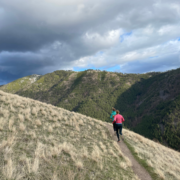By: Sam Van de Velde
Exercise Physiologist at Sapphire Physical Therapy (and RE’s newest employee!)
How to get better at running uphill
A large component of uphill running is based on having an efficient cardiovascular system. There is a specificity component to uphill running, that when trained, can improve your total economy. Below are various workouts to incorporate into your training plan and before you know it, you will be running longer and stronger.
Alternating Uphill Workouts to improve Uphill capabilities
Power hike/jog repeats: I like to ride my bike for a warm-up to the M or Mt. Sentential. Next, complete repeat efforts of 2 minutes power hiking followed by 2 minutes fast feet jogging, for a total of 1-4 sets (depending on fitness level). Rest 2-3 mins between sets. On the recovery interval it is important to keep moving.
Vo2 max hill repeats
5 x 2-3 min uphill running (2 min recovery after each repetition) at challenging effort
Sustained Threshold Efforts
Find a gradual hill for a steady effort that is runnable
4 x 6-10 minutes moderately challenging (2 min recovery)
Fun Physiology fact
When we are on a steep trail, it can be more efficient to hike than run. While hiking, the Tibialis Anterior muscle (near your shin) increases activation by 30% (compared to running). If hiking is not trained, there is potential to overload other small muscle groups that are similar to tibialis anterior. Point blank, hiking is an important component of trail running.
Strength Training is another excellent tool for improving your uphill running.
Methods of Training for the Downhill
Running hard downhill, similar to how you would train for uphill running, will not provide the same benefit. When completing hard downhill intervals, a physiological phenomenon called DOMS (Delayed Onset Muscle Soreness) will potentially occur a few days later. Runners can experience a 4-7 percent reduction in running economy for several days, potentially subjecting runners to overuse injuries¹. It is very important to prepare the legs, specifically the quadriceps, for the descents. For races like the Double Dip or the Run the Rut, research shows racers speed over the course of the race drastically decreases on the downhill sections toward the end of the race². This is because of the impact downhill running has on major muscle groups. Races aren’t necessarily 100% won on the downhill alone, but they can be lost. Downhill running should be trained with caution and intention.
Downhill Training tips
Run quiet
It is natural for a runner to increase their time in the air so that the heel can land and then apply the brakes. Instead, tell yourself, “I am going to run as quiet as possible.” The easiest way to accomplish this is to increase step cadence and land on the mid to forefoot. This will allow you to keep your weight over your feet and prevent your torso from leaning back into the brake position.
Mantra: “I am going to run quiet and light”
Use your vision
Use your vision to help anticipate the next rock or root. Our peripheral vision does a good job of reading the surrounding area. I like to challenge my athletes to look as far down the trail as they can while running downhill. Looking directly down at your feet is a similar feeling to when you are driving and you look down at the stereo and then back up at the road and feel disoriented.
Favorite Running Workout
8 x 20 second downhill technique drills based on previous tips (can increase time depending on your training history and cycle).
I.E: 20 seconds of shortening your stride, looking down the trail and working with gravity. Followed by 20 seconds- walking or stopping, Repeat x 8
If you aren’t satisfied with your results, come see us at Backcountry Coaching:
Contact: backcountrycoaching@gmail.com
Sources
Chen, T.C., Nosaka, K. and Tu, J.H., 2007. Changes in running economy following downhill running. Journal of sports sciences, 25(1), pp.55-63.
Kerhervé, H.A., Cole-Hunter, T., Wiegand, A.N. and Solomon, C., 2016. Pacing during an ultramarathon running event in hilly terrain. PeerJ, 4, p.e2591.





